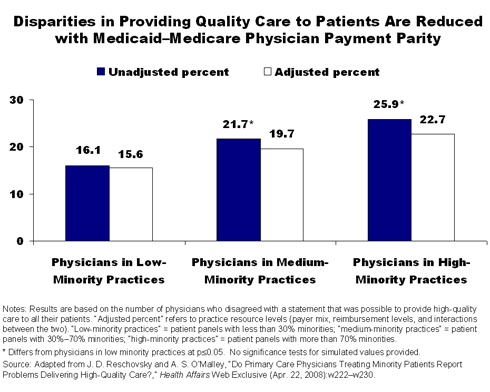Primary care physicians who treat a disproportionate share of black and Latino patients provide more charity care, see more patients, depend more heavily on low-paying Medicaid, and earn lower incomes than physicians seeing mostly white patients, a Commonwealth Fund–supported study finds.
Such practice constraints play an important role in why physicians treating large numbers of minority patients report more problems delivering high-quality care than other physicians—from spending an average of 30 percent less time per patient to having a harder time obtaining specialty care, conclude the authors of "Do Primary Care Physicians Treating Minority Patients Report Problems Delivering High-Quality Care?" (Health Affairs Web Exclusive, Apr. 22, 2008).
"Our results indicate that the minority makeup of physicians' patient panels is associated with greater reports from physicians of difficulties providing high-quality care," write James D. Reschovsky and Ann S. O'Malley, senior health researchers at the Center for Studying Health System Change. The study sheds new light on pervasive racial and ethnic health disparities in the United States by looking beyond individual patient characteristics to community and physician practice resources. The study also examines how higher Medicaid payments might help physicians provide high-quality care.
Practice Resources Skewed
There is broad consensus regarding the existence of racial and ethnic disparities in health care, but disagreement about the root causes. Using data from the 2004–05 Community Tracking Study Physician Survey, the authors build on research that goes beyond assessing patients' characteristics to examine how the aggregate socio-economic and insurance composition of a provider's patient base contributes to racial disparities. The authors focused specifically on the experiences of 3,320 primary care physicians.
Most (52%) physicians examined had patient panels with less than 30 percent minorities (i.e., low-minority practices), about a third (36%) reported that 30 percent to 70 percent of their patients were black or Hispanic (i.e., medium-minority practices), and 12 percent said that minorities made up more than 70 percent of their patients (i.e., high-minority practices).
"[P]hysicians with greater portions of minority patients were located in areas with lower median incomes and higher uninsurance rates," the researchers say. Moreover, physicians in high-minority practices depended on Medicaid for more than a third of their revenue, or more than twice that of physicians in low-minority practices.
Compared with physicians treating primarily white patients, the researchers found that physicians treating higher percentages of minorities were more likely to report that patients' inability to pay for care was a major problem (35% vs. 23%) and report more patients who speak another language (6.8% vs. 2.2%). Physicians treating higher percentages of blacks and Hispanics were more likely to be women and minorities themselves. Also, such physician practices were located in areas where private insurance reimbursement rates were lower and where the ratio of Medicaid reimbursements to higher-paying Medicare reimbursements was lower.
Lack of Resources and Effects on Quality
Compared with physicians treating fewer minority patients, clinicians whose patients are more likely to be minorities reported more quality-related difficulties. For example, 26 percent of physicians in high-minority practices disagreed that it was possible to provide high-quality care to all of their patients, compared with 16 percent of those in low-minority practices.
"Physicians in high-minority practices reported greater difficulty obtaining specialty care for their patients because patients were uninsured or had insurance coverage that posed access barriers, but not because of an inadequate supply of qualified specialists in the area," said the researchers.
When researchers modeled the likely effect of raising Medicaid payments so that they equaled Medicare payments to physicians, they found improvements on several measures, particularly for physicians with high-minority practices. For example, among physicians in high-minority practices, the percentage reporting inadequate time with patients as a major problem was reduced by 5.8 percentage points.
Conclusions
The results of the study, say the authors, suggest that racial and ethnic disparities in primary health care are partly systemic in nature, with the lack of physician resources a contributing factor.
Legislators and policymakers should not assume that physicians can simply shift costs so that Medicaid patients receive the same care as do other patients. Instead, policies are needed to raise payment rates for Medicaid, extend insurance coverage to the uninsured, and increase resource flow to physicians who serve low-income and minority populations. These steps, say the authors, may work to reduce disparities among patients.
Additional charts from the authors are available at http://www.commonwealthfund.org/usr_doc/Reschovsky_chartpack.pdf?section=4039.



